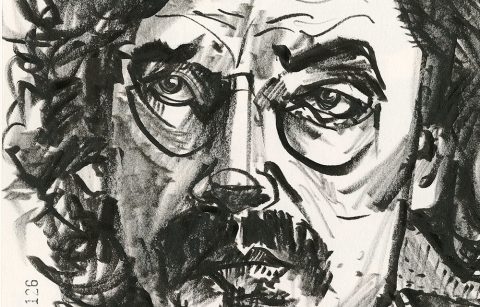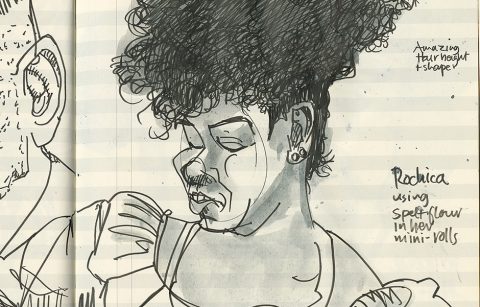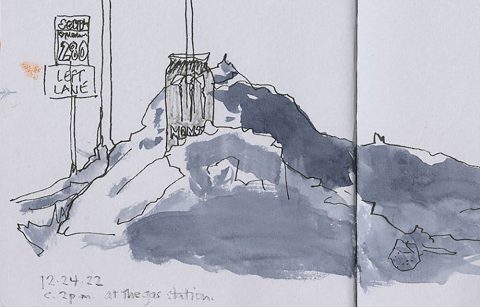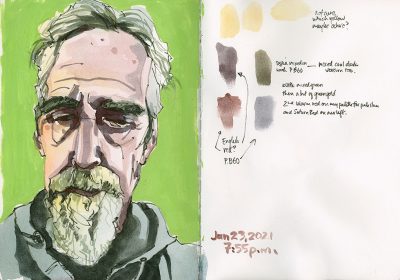
Often I’ll make my color notes on the same page spread when I’m working. This is a brush pen sketch and watercolor in an Arteza Watercolor sketchbook that’s about 9 x 11 inches. (You can read my review comments about this sketchbook by using the keyword in this blog’s search engine. Basically, not a fan, and have some of these to use up as they came in packs and pairs.)
It’s important to be as specific as possible for your notes. Brief yes, but intelligible.
Here I have to call myself out. I would swear just looking at this without the notes that I also had some perylene green in the darker/neutralized mixes. I’ll have to follow my swatches and see what happens.
But it’s funny too because people often ask me when I’m sketching blond or white hair, What’s that yellow pigment you’re using?
HAHAHAHAHA. It’s green gold which washes out to a very pale yellow. (Here in the hair, mustache, and beard.) If I didn’t have those notes and didn’t remember that at this time of my life I was using a lot of green gold I would wonder and wonder.
As it was I didn’t jot down the yellow I used as a first layer in the face so I do have to guess on that one—as you see I did on the day, having already distractedly picked a color and applied it and moved on.
Are these discrepancies enough to toss out my note taking habit?
Nope!
Far too many things have been saved from the oblivion of my failed memory to do that. Sure I can take educated guesses and retest and come to the correct answer to fill those omissions, it’s what sometimes I must do when I have an omission. But if you multiply that by say 1,000,000 times you might casually forget something it’s a lot of repetition and I want to move on to other things.
Imperfect though it is I’ll keep note taking, it’s simply easier in the long run.
Another Reason to Keep Color Notes
I like to push myself to try new combinations of pigments—to get more realistic colors, or to move away from realistic colors. I like to find new combos. Sometimes I have a new pigment I’m testing with favorite colors just to see that that pigment does to my usual pattern of color mixing.
You never know, there might be a better way to get a color and value faster when I need it. It’s worth looking into.
Swatches I make when doing these tests help me delete pigments from my palette and focus on colors that I use repeatedly.
These color notes also help me work out new pairings and groups of colors that I want to plan entire paintings round.
Again, I think making color notes (with swatches as shown on the recto page of today’s image) are a positive aid. And because I index my journals I can do keyword searches such as “PB60,” or “Green gold” and come up with journal pages where I have these charts. I can review them quickly before starting a new painting with those colors, switching out some pigments and adding others.
Other times the swatches simply serve as a bit of forensic detail, when I try to reconstruct the palette I was using at the time—because I always have a couple watercolor box palettes going.
I also squeeze tube color out on porcelain plates when painting in the studio, and often work for days using “leftover” paint, making all the sketches during that period somehow relate to each other because of this. And when you have several colors all mixed up on your palette, that’s a nice time to remember what is in those mixes, and maybe even start a new palette.
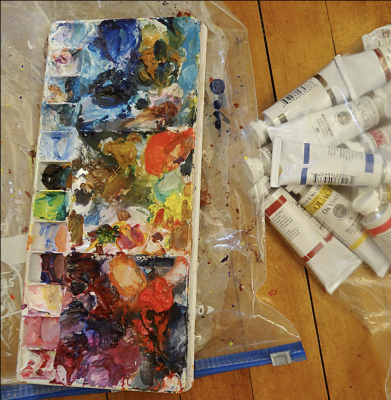
Just for grins I remembered that my “leftover” palette got pretty intense during my 2013 International Fake Journal Month Journal. I don’t have access to the photos for that time (because of my digital storage problems which are on-going since February 2, 2021, yes I remember the date my orderly life fell totally apart) but I nabbed this screen shot, which is clear enough to see that yep, I had some warm and cool organization going on, and tried to keep the white away from everything (mixing with white only in certain separated areas of the larger wells); and that I am not at all shy about pigment contamination. But in my defense I find that putting fresh tube color on top of dried paint of the same color creates a “platform” of safety. And what’s a girl to do when she likes to have the pigments separate on her brush at the same time?
It all works out. You find a way. I recommend note taking to speed that way along.
Oh, and if you don’t remember I am not a fan of DaVinci Gouache and you can read about it in this post.




















